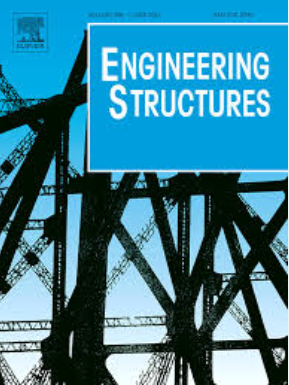基于假设模态加权的平面桁架结构低维动力学建模
IF 6.4
1区 工程技术
Q1 ENGINEERING, CIVIL
引用次数: 0
摘要
由众多细长梁组成的平面桁架结构在外力作用下表现出复杂的耦合和非线性行为。精确的低维动力学模型对于分析其非线性行为和控制振动至关重要。本文提出了一种新的平面桁架结构解析建模方法——桁架解析模态法(TAMM)。该模型基于模态坐标装配和假设模态加权,解决了有限元中存在的高自由度问题,克服了等效建模方法(EMM)在捕获局部振动和建模变高桁架结构方面的局限性。每个梁和连接点单独编号,用两个平移弹簧和一个旋转弹簧模拟每个节点梁之间的约束。利用无约束模态推导出了每根梁的动能和势能以及相应的质量和刚度矩阵和弹性约束。然后将这些矩阵组装成整体质量和刚度矩阵,从而形成桁架结构的假设模式(AM)模型。通过求解AM模型的特征向量得到全局模态,并利用全局模态建立考虑细长构件几何非线性的非线性动力模型。用有限元法建立的动力学模型的解验证了所提方法的有效性。与有限元法相比,TAMM法计算固有频率所需的计算时间缩短了88 %。典型工程实例的数值模拟表明,全局模态反映了桁架结构的整体和局部振动特性。弹性连接的转动刚度对整体振动影响不大,但对局部振动影响较大。本文章由计算机程序翻译,如有差异,请以英文原文为准。
Low-dimensional dynamic modeling for planar truss structures using assumed mode weighting
Planar truss structures, composed of numerous slender beams, exhibit complex coupling and nonlinear behavior under external excitations. Accurate, low-dimensional dynamic models are essential for analyzing their nonlinear behavior and controlling vibrations. This study presents a novel analytical modeling approach, the Truss Analytical Mode Method (TAMM), for planar truss structures. The TAMM, based on mode coordinate assembly and assumed mode weighting, addresses the high-degree-of-freedom challenges in FEM and overcomes the limitations of the Equivalent Modeling Method (EMM) in capturing local vibrations and modeling variable-height truss structures. Each beam and connection point is individually numbered, and two translational springs and one rotational spring are used to simulate the constraints between beams at each node. The kinetic and potential energies and the corresponding mass and stiffness matrices of each beam and elastic constraint are derived using the unconstrained modes. These matrices are then assembled to form the overall mass and stiffness matrices, resulting in the truss structure's Assumed Mode (AM) model. The global modes are obtained by solving the eigenvectors of the AM model and are further used to establish the nonlinear dynamic model considering the geometric nonlinearities in slender components. The solution of the dynamic model established by the FEM is used to verify the validity of the proposed approach. The computation time required by the TAMM to calculate the natural frequencies is reduced by 88 % compared to that of the FEM. Numerical simulations of typical engineering examples show that the global modes capture the truss structure's overall and local vibration characteristics. While the rotational stiffness of elastic connections has little effect on global vibration, it significantly influences local behavior.
求助全文
通过发布文献求助,成功后即可免费获取论文全文。
去求助
来源期刊

Engineering Structures
工程技术-工程:土木
CiteScore
10.20
自引率
14.50%
发文量
1385
审稿时长
67 days
期刊介绍:
Engineering Structures provides a forum for a broad blend of scientific and technical papers to reflect the evolving needs of the structural engineering and structural mechanics communities. Particularly welcome are contributions dealing with applications of structural engineering and mechanics principles in all areas of technology. The journal aspires to a broad and integrated coverage of the effects of dynamic loadings and of the modelling techniques whereby the structural response to these loadings may be computed.
The scope of Engineering Structures encompasses, but is not restricted to, the following areas: infrastructure engineering; earthquake engineering; structure-fluid-soil interaction; wind engineering; fire engineering; blast engineering; structural reliability/stability; life assessment/integrity; structural health monitoring; multi-hazard engineering; structural dynamics; optimization; expert systems; experimental modelling; performance-based design; multiscale analysis; value engineering.
Topics of interest include: tall buildings; innovative structures; environmentally responsive structures; bridges; stadiums; commercial and public buildings; transmission towers; television and telecommunication masts; foldable structures; cooling towers; plates and shells; suspension structures; protective structures; smart structures; nuclear reactors; dams; pressure vessels; pipelines; tunnels.
Engineering Structures also publishes review articles, short communications and discussions, book reviews, and a diary on international events related to any aspect of structural engineering.
 求助内容:
求助内容: 应助结果提醒方式:
应助结果提醒方式:


